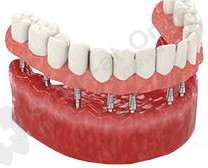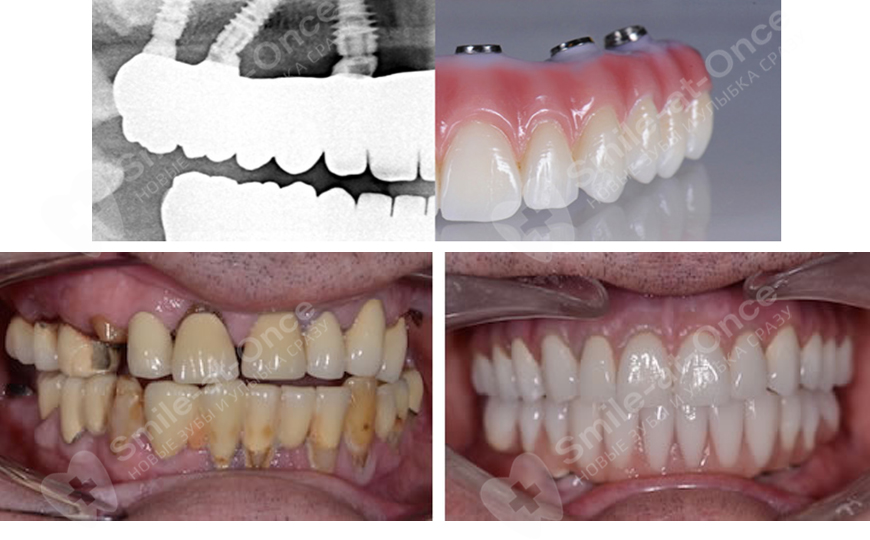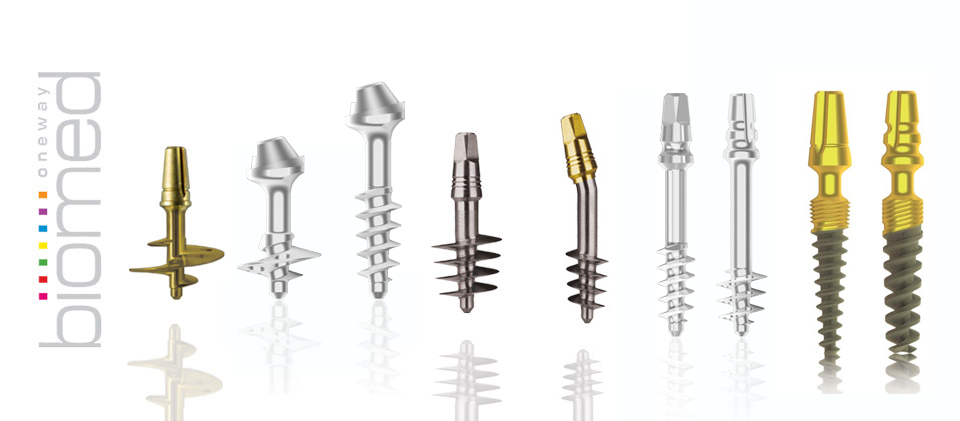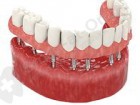Basal implantation
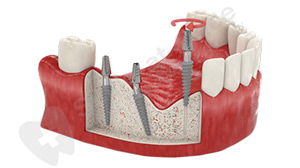 Basal implantation of teeth is a new technique that allows you to install implants in the hard parts of the jaw bone: the basal layer and cortical plate. Thus, it is possible to effectively solve the problem of full or partial adentia, even with severe atrophy of the jawbone. A feature of basal implantation, in comparison with other methods, is that implants are loaded with dentures instantly. Hence the original name of the implantation protocol - this is implantation with instant loading or Immediate Load Implantation.
Basal implantation of teeth is a new technique that allows you to install implants in the hard parts of the jaw bone: the basal layer and cortical plate. Thus, it is possible to effectively solve the problem of full or partial adentia, even with severe atrophy of the jawbone. A feature of basal implantation, in comparison with other methods, is that implants are loaded with dentures instantly. Hence the original name of the implantation protocol - this is implantation with instant loading or Immediate Load Implantation.
The terms express, basal, single-phase, simultaneous implantation, etc. - these are all advertising tricks of dentistry that try to stand out in the market.
In this article we will analyze each name and tell in detail about the technology of implantation with instant loading, so that patients can understand how the implantation process occurs and what is its uniqueness. Implantation with instant loading has received many synonyms, due to its properties:
- Basal implantation - due to the fact that the implants are installed in addition to the alveolar section in the basal, using the cortical plate;
- Express implantation - an advertising move, meaning that the patient restores the root of the tooth and its crown part almost simultaneously;
- One-stage or one-stage dental implantation- this is the technology of implant placement immediately after tooth extraction (in the hole), which is applicable both for the classical implantation protocol and for implantation with instant loading;
- Single phase implantation - also an advertising move, it implies that the installation of the implant and the prosthesis pass in one stage (phase);
- One-piece or monoblock implantation - the term is quite rare, sometimes used in dental circles and does not characterize the technique, but the type of implant used for instant loading. As a rule, they are one with the root part of the implant and the abutment on which the prosthesis is attached;
- Minimally invasive or transgingival implantation - means that the implants are installed by puncture without incision of soft tissues, immediately through the gum or into the hole of the tooth just removed (simultaneously);
- Compression implantation - the name comes from the method of screwing the implants into the bone - on the principle of “screw-self-tapping”, that is, the own bone tissue is not lost, but amenable to compression, creating excellent conditions for the primary stability of the implants in the bone;
Immediate loading implantation is truly revolutionary due to the fact that: Due to the above properties, the patient does not need to wait for the complete implant engraftment to start chewing food.The key factor in the success of implantation with instant loading is precisely the provision of a chewing load on the bone and stimulation of the blood circulation in its cells. Thus, bone tissue comes to life and the natural process of cell regeneration is normalized. The process of osseointegration (implant survival) occurs simultaneously with the operation of new teeth.
Indications
- Single restorations,
- partial or complete adentia (absence of teeth),
- periodontitis and periodontal disease,
- bone tissue problems: a decrease in its volume after tooth loss,
- the impossibility or unwillingness of the jaw bone extension,
- the need for quick tooth restoration.
Contraindications
Basal implantation has far fewer contraindications than the classical protocol. At the same time, with serious problems of the body, it is still forbidden to carry it out - serious complications and rejection of established structures are possible:
- uncompensated diabetes
- serious disorders of the immune, nervous, cardiovascular systems,
- infectious diseases: HIV, AIDS, tuberculosis,
- malignant tumors of any organs,
- tone of masticatory muscles.
Diseases of the teeth and gums, smoking, periodontitis, as well as poor oral hygiene are not contraindications for implantation - it is enough to stop the acute period, to qualitatively remove all bacteria and germs from the oral cavity.
Implantation with an instant loading of 90% is recommended in the absence of a large number of teeth or at least 3. If only one tooth is missing in a row, this technique is applicable and works successfully, but it is important for the patient to understand that for single restorations the requirements for bone tissue are slightly higher and, most likely, gum plastic is required (to install a prosthesis on one tooth with an artificial gum, when it sags, which will hide the defect, it is impossible).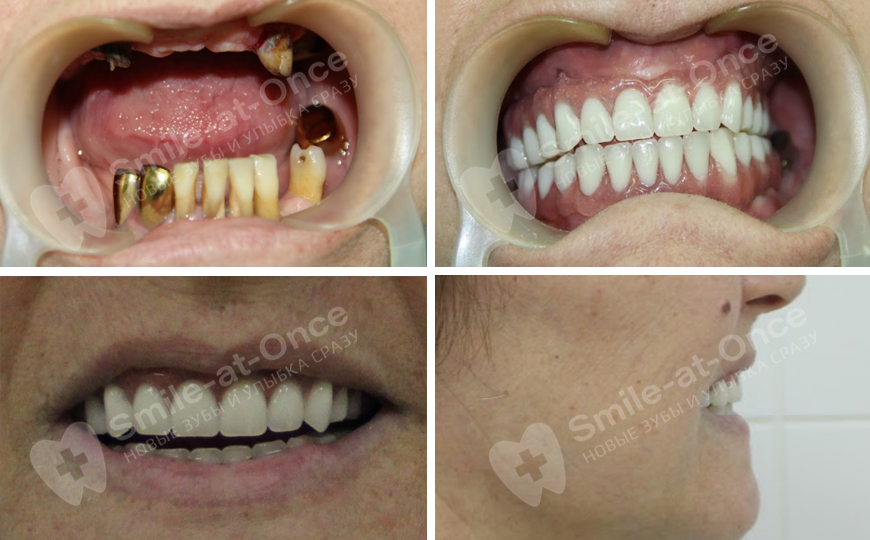
Method Advantages
- restoration of teeth in 3-7 days - precisely the teeth with which you can chew and smile,
- implantation immediately after tooth extraction,
- safe, low-traumatic implant placement and quick rehabilitation,
- activation of natural nutritional metabolism in bone cells,
- no need to build bone in 90% of all cases,
- permanent dentures are installed immediately
- the cost of restoring the entire jaw is 2 times lower than the classical approach.
Tooth extraction: how does it affect bone?
Human bone tissue consists of three layers: the central cancellous bone, the deep basal region and the cortical plate, that is, the membrane. Dental roots, located in the spongy bone, actively affect the multiple capillaries located in it - due to this, nutrition and oxygen saturation of the tissue occur. As soon as the roots of the teeth are removed, the system of work is broken and the bone tissue (namely, the spongy section) is reduced - there is a concept bone atrophy. At the same time, the basal and cortical layers of atrophy are not exposed, since they consist of mineral salts and bone partitions, that is, they can be safely used to install implants.
Bone tissue atrophy: how to restore teeth?
Bone tissue atrophy complicates not only implantation, but also conventional prosthetics, since the gum sags, the alveolar ridge may become too narrow. In order to install classical implants, a sufficient volume of the central bone section is required.
If it is not enough, a preliminary build-up or sinus lift on the upper jaw is required. Ordinary prostheses can be installed, but their regular relocation will be required, because the level of gums and bone tissue will be reduced due to lack of load.
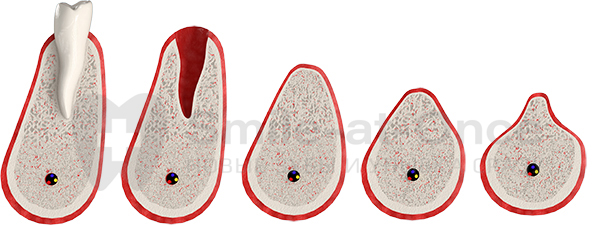 Implantation with instant loading (basal) is the only method that can be performed in 90% of cases without first increasing the bone volume. An important feature of the method is that it is special in form and method of installation implants allow you to work with all three departments of bone tissue. When they are installed around the implants, a dense cortical layer or hard shell is formed, which provides excellent primary stabilization of the structures and is a kind of foundation. It does not dissolve for many months and is replaced by the main bone only as it actively grows and penetrates the porous coating of the implants. When applying the basal implantation technique with instant loading, it is possible to bypass the most atrophied areas of the bone and to do without its preliminary build-up even in especially difficult cases.
Implantation with instant loading (basal) is the only method that can be performed in 90% of cases without first increasing the bone volume. An important feature of the method is that it is special in form and method of installation implants allow you to work with all three departments of bone tissue. When they are installed around the implants, a dense cortical layer or hard shell is formed, which provides excellent primary stabilization of the structures and is a kind of foundation. It does not dissolve for many months and is replaced by the main bone only as it actively grows and penetrates the porous coating of the implants. When applying the basal implantation technique with instant loading, it is possible to bypass the most atrophied areas of the bone and to do without its preliminary build-up even in especially difficult cases.
Technology and stages of implantation
Modern techniques of implantation with instant loading are divided into several technologies, where, depending on the situation, the most effective treatment protocol is used. Dental implantation according to the Immediate Load protocol was developed by the leading implantologists of Europe, members of the International Implant Foundation, which brought together the most advanced technologies in the field of implantology and tooth restoration. Oneway Biomed is the official representative of original basal implants in Russia and is part of the Implant Foundation, a European research center founded in Switzerland more than 40 years ago.
Applied Technologies:
- BASAL COMPLEX - for the rehabilitation of patients with severe forms of bone atrophy (especially in the sinus area), complicated by sinusotomy, generalized periodontitis and periodontal disease;
- ALL-ON-6 - moderate degree of atrophy, periodontitis II degree, diabetes mellitus, localized cystic formations on the root of the teeth;
- ALL-ON-4 - medium degree of atrophy, favorable quality of bone tissue without inflammatory processes;
- InstanTeeth - for single restorations and restoration of segments, including atrophy of bone tissue.
Key moments of implantation:
- implants: artificial roots have a one-piece construction, they are single-component, which allows you to start prosthetics immediately, skipping the installation phase of abutments,
- implant fixation: artificial roots in bone tissue are fixed in an atraumatic manner, that is, without creating a bed using boron. Instead, the gum is pierced and the implant is screwed into the bone. This approach provides maximum sterility, and therefore significantly reduces the risk of tissue inflammation and subsequent implant rejection. In addition, there is a clear plus for the patient - rehabilitation after surgery is quick and very comfortable, without pain and swelling,
- lack of implant placement restrictions: constructions for basal implantation can be installed even at an angle (classic - only parallel to each other). This allows you to bypass the bone with a small volume, and stability to the implants gives a durable prosthesis that connects them together and fixes in a stationary state,
- no bone volume limits: In 90% of cases, it is possible to do without tissue buildup before implant placement That is, implantation is possible regardless of the state of the jawbone,
- instant prosthetics: dentures are installed 2-3 days after implantation. Firstly, they stabilize artificial roots, and secondly, they serve for additional nutrition of bone cells - due to the load from implants during chewing, bone capillaries work actively, transferring nutrients to cells. Due to this, the activation of natural processes takes place, and the bone is restored many times faster,
- minimum contraindications: basal implantation is the only technique that is carried out in acute inflammatory processes on the gums.
Implantation Stages
- preparation: assessment of the state of bone tissue and the body, passing tests, choosing a place for installing implants,
- three-dimensional modeling of the treatment process,
- creation of surgical templates and installation of implants on them,
- direct installation of prostheses and casting,
- adaptation of abutments,
- prosthesis manufacturing and fixation.
Types of implants for implantation with instant loading
Implantation with instant loading in Russia mainly uses Oneway Biomed basal and compression implants. They have a classic root shape, but are specially adapted for the installation of prostheses immediately after implantation, as well as for fastening in the basal and cortical layers.
Immediate load implants - new generation implants presented by Swiss and German brands such as Nobel, Alpha Dent, Roott. They can be one-part or two-part, but the principle of their work combines the properties of basal and cortical in one. For each individual case, their sizes are simply selected.
Basal implants are used for acute deficiency of the jawbone. They have an aggressive thread with wide petals at the base, which ensures their excellent fixation in both the basal and cortical layers. Designs perfectly distribute the chewing load due to the support at several points. Cortical or compression implants thinner, used in combination with basal. They can be fixed at different angles in the jaw, ensuring the stability of the entire system to restore lost teeth.
Implant implant prosthetics
During implantation with instant loading, there are no restrictions on prosthetics - both permanent and removable prostheses can be fixed on artificial metal roots. However, in acute atrophy of bone tissue, prostheses made of metal-plastic or plastic (a light material that can be easily adjusted if necessary) with a plastic gum created from soft and aesthetic, modern and hypoallergenic materials are selected for the first year. Plastic gum allows you to hide a broken aesthetics and sagging bone with the gum, it is completely invisible and does not cause discomfort.

Implant life with immediate loading
With a careful attitude, implants that have taken root will last a lifetime - since titanium is absolutely biocompatible with the body .. Dentures serve a little less, but they are easily updated without replacing the implants.
Although if you install prostheses made of zirconium dioxide, then this design will last at least 20 years.
Naturally, the patient himself needs to monitor the condition of the body, treat dental diseases, gums on time and do not forget about hygiene.
The cost of basal implantation
Complete complex implantation with instant loading during restoration of one or both dentitions costs almost 2 times cheaper than the classical approach. Savings arise due to the reduction in the stages of treatment (no need to increase bone tissue), reducing the number of visits to the doctor. At the same time, quality and service life are maintained at a similarly high level.The average cost in Moscow for the restoration of all teeth in 1 jaw, including the installation of a prosthesis, diagnostics, implantation and all necessary manipulations, is from 220 000 rub. - 280 000 rub.
Reviews of patients choosing this type of implantation:
- The dentist told me about the method of basal implantation when I had to remove another tooth. I very much doubted the choice of the method of tooth restoration. In fact, this operation turned out to be a fairly simple procedure. One of the advantages of the operation is that in ten days I was able to eat my favorite foods and enjoy my smile.
- I had only two teeth left on the upper jaw, on the lower jaw there were also several teeth. The thought that I would have to wear a removable denture led me to despair. The dentist convinced me that my case was suitable for basal dental implants. I was very surprised, but agreed. Now I have wonderful teeth and I can smile freely.
- For three years I used removable dentures. There are very few teeth in the mouth. My dentist suggested a basal implant, but on condition that I give up smoking. I reluctantly agreed. After the operation, I felt unwell, there were painful sensations in my mouth and I really wanted to smoke. Three days after the operation, a prosthesis was installed and, when I saw my new teeth, I received a lot of positive emotions.
- A few years ago she did basal implantation. First, light plastic crowns were placed, and a year later - from cermets. Teeth like real. So far there have been no problems.
- Nikolay Namdakov, maxillofacial surgeon, implant dentist of innovative technologies dentistry “SMILE-AT-ONCE”: “The development of basal implantation in the world is undoubtedly the merit of the Swiss scientist and professor of dental implantology Stefan Ide, who in the course of his practical observations revealed that the immediate load on the implants allows to accelerate the process of osseointegration, while providing the patient with“ new teeth ”right away. The fact that the single-stage implantation of ILI (Immediate Load Implantation) is really effective proves its rapid development throughout the world. Over the 7 years of my own practice of tooth restoration in complex cases of atrophy, periodontitis, sinusotomy and malocclusion using various approaches, I came to the conclusion that basal implantation is the most optimal, and most importantly safe and correct way to restore chewing function. ”
